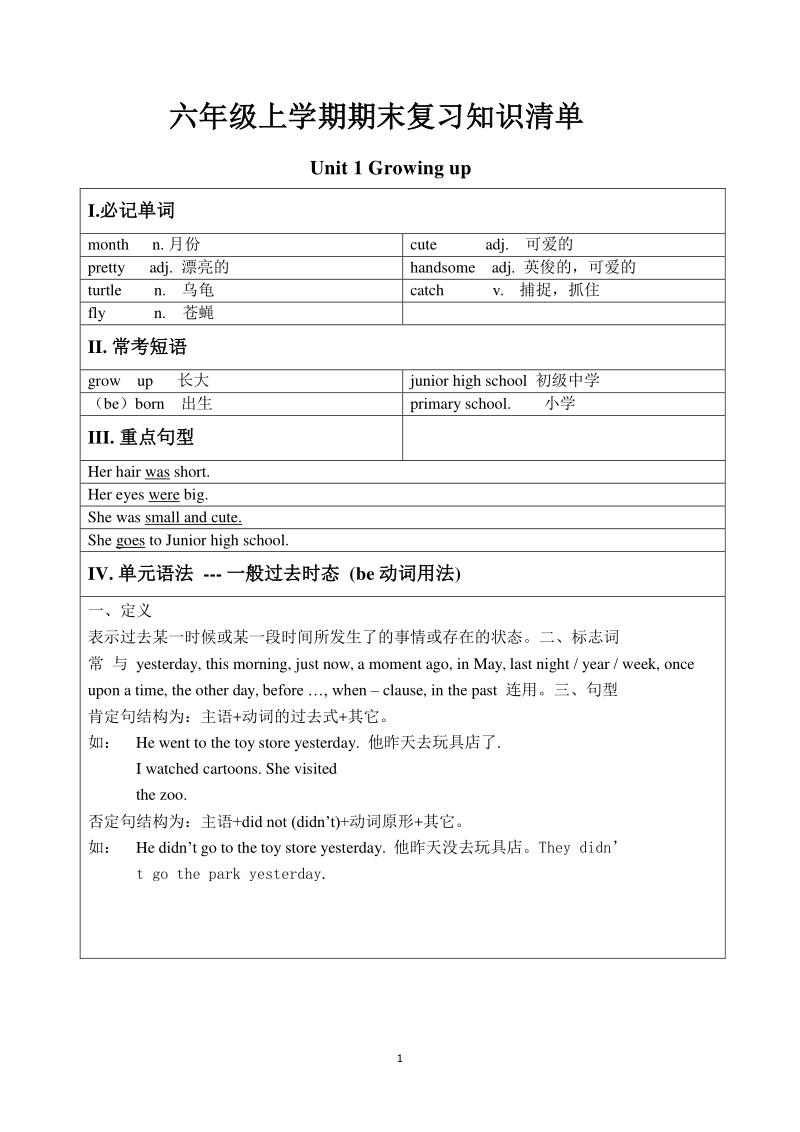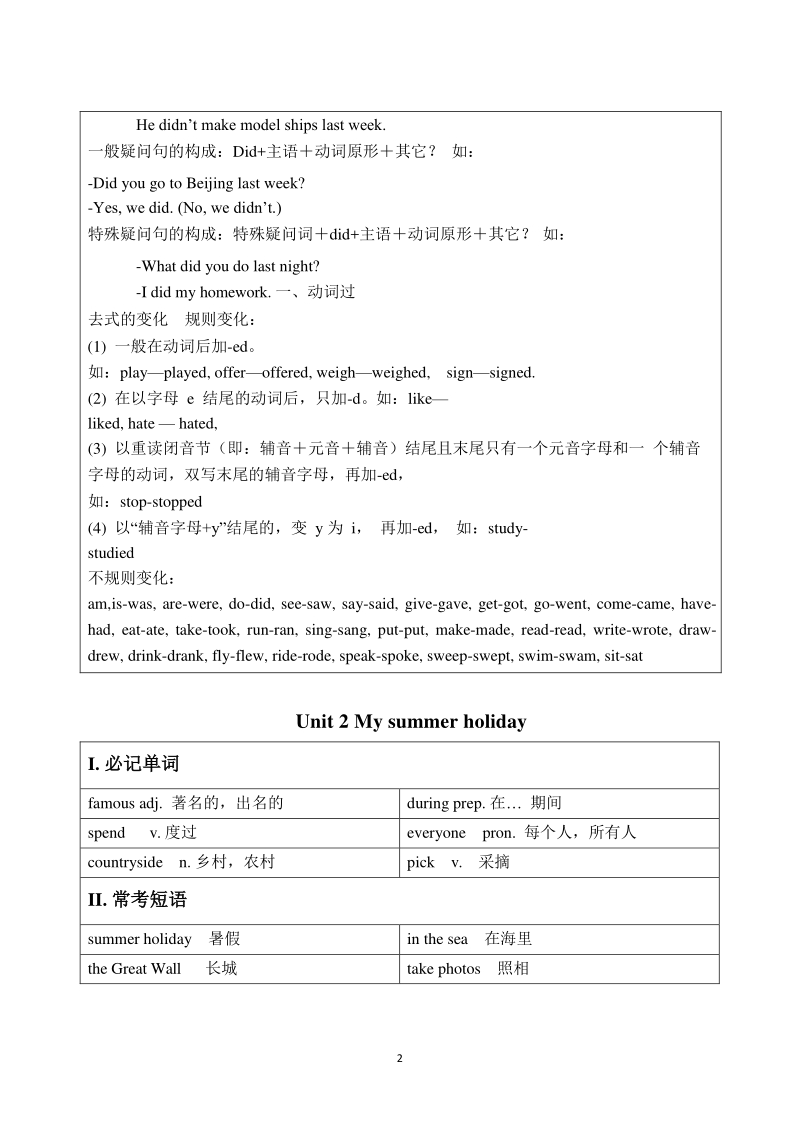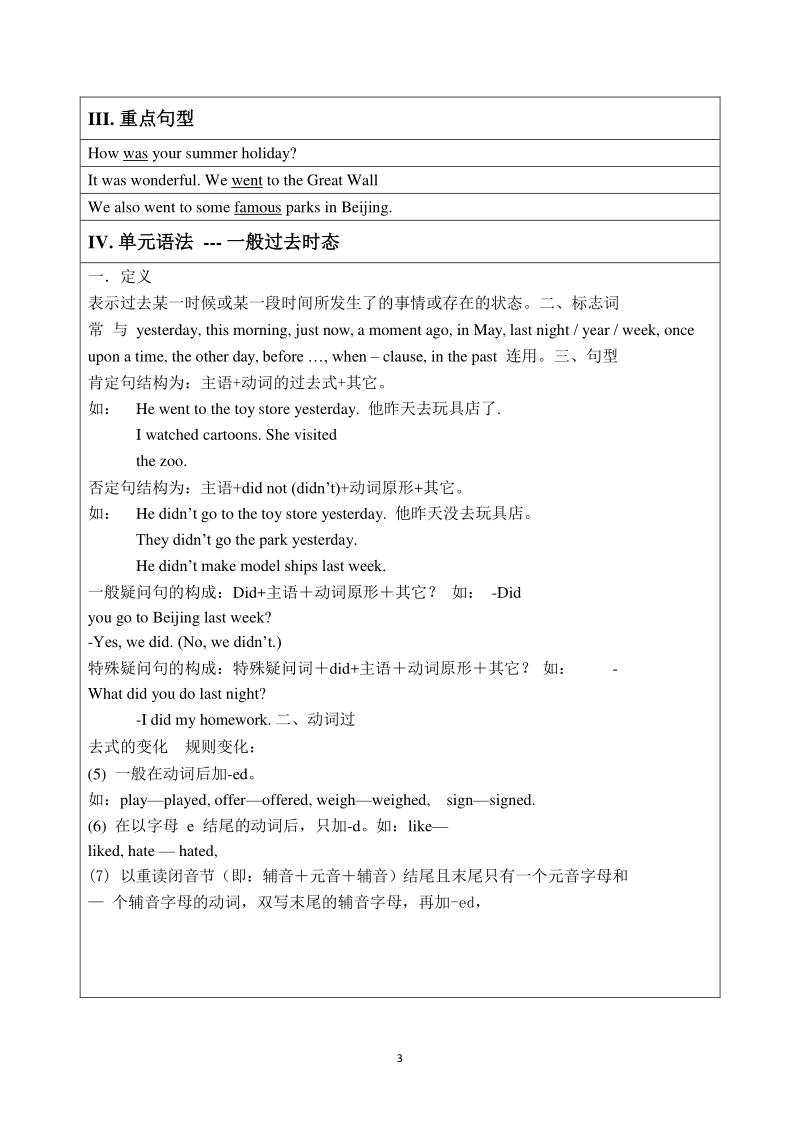 2021年沪教牛津版(深圳用)六年级上英语期末复习知识点清单
2021年沪教牛津版(深圳用)六年级上英语期末复习知识点清单
《2021年沪教牛津版(深圳用)六年级上英语期末复习知识点清单》由会员分享,可在线阅读,更多相关《2021年沪教牛津版(深圳用)六年级上英语期末复习知识点清单(16页珍藏版)》请在七七文库上搜索。
1、1 六年级上学期期末复习知识清单六年级上学期期末复习知识清单 Unit 1 Growing up I.必记单词必记单词 month n. 月份 cute adj. 可爱的 pretty adj. 漂亮的 handsome adj. 英俊的,可爱的 turtle n. 乌龟 catch v. 捕捉,抓住 fly n. 苍蝇 II. 常考短语常考短语 grow up 长大 junior high school 初级中学 (be)born 出生 primary school. 小学 III. 重点句型重点句型 Her hair was short. Her eyes were big. She wa
2、s small and cute. She goes to Junior high school. IV. 单元语法单元语法 - 一般过去时态一般过去时态 (be 动词用法动词用法) 一、定义 表示过去某一时候或某一段时间所发生了的事情或存在的状态。二、标志词 常 与 yesterday, this morning, just now, a moment ago, in May, last night / year / week, once upon a time, the other day, before , when clause, in the past 连用。三、句型 肯定句结构为:
3、主语+动词的过去式+其它。 如: He went to the toy store yesterday. 他昨天去玩具店了. I watched cartoons. She visited the zoo. 否定句结构为:主语+did not (didnt)+动词原形+其它。 如: He didnt go to the toy store yesterday. 他昨天没去玩具店。They didn t go the park yesterday. 2 He didnt make model ships last week. 一般疑问句的构成:Did+主语动词原形其它? 如: -Did you
4、go to Beijing last week? -Yes, we did. (No, we didnt.) 特殊疑问句的构成:特殊疑问词did+主语动词原形其它? 如: -What did you do last night? -I did my homework. 一、动词过 去式的变化 规则变化: (1) 一般在动词后加-ed。 如:playplayed, offeroffered, weighweighed, signsigned. (2) 在以字母 e 结尾的动词后,只加-d。如:like liked, hate hated, (3) 以重读闭音节(即:辅音元音辅音)结尾且末尾只有一
5、个元音字母和一 个辅音 字母的动词,双写末尾的辅音字母,再加-ed, 如:stop-stopped (4) 以辅音字母+y结尾的,变 y 为 i, 再加-ed, 如:study- studied 不规则变化: am,is-was, are-were, do-did, see-saw, say-said, give-gave, get-got, go-went, come-came, have- had, eat-ate, take-took, run-ran, sing-sang, put-put, make-made, read-read, write-wrote, draw- drew,
6、drink-drank, fly-flew, ride-rode, speak-spoke, sweep-swept, swim-swam, sit-sat Unit 2 My summer holiday I. 必记单词必记单词 famous adj. 著名的,出名的 during prep. 在 期间 spend v. 度过 everyone pron. 每个人,所有人 countryside n. 乡村,农村 pick v. 采摘 II. 常考短语常考短语 summer holiday 暑假 in the sea 在海里 the Great Wall 长城 take photos 照相
7、3 III. 重点句型重点句型 How was your summer holiday? It was wonderful. We went to the Great Wall We also went to some famous parks in Beijing. IV. 单元语法单元语法 - 一般过去时态一般过去时态 一定义 表示过去某一时候或某一段时间所发生了的事情或存在的状态。二、标志词 常 与 yesterday, this morning, just now, a moment ago, in May, last night / year / week, once upon a
8、time, the other day, before , when clause, in the past 连用。三、句型 肯定句结构为:主语+动词的过去式+其它。 如: He went to the toy store yesterday. 他昨天去玩具店了. I watched cartoons. She visited the zoo. 否定句结构为:主语+did not (didnt)+动词原形+其它。 如: He didnt go to the toy store yesterday. 他昨天没去玩具店。 They didnt go the park yesterday. He d
9、idnt make model ships last week. 一般疑问句的构成:Did+主语动词原形其它? 如: -Did you go to Beijing last week? -Yes, we did. (No, we didnt.) 特殊疑问句的构成:特殊疑问词did+主语动词原形其它? 如: - What did you do last night? -I did my homework. 二、动词过 去式的变化 规则变化: (5) 一般在动词后加-ed。 如:playplayed, offeroffered, weighweighed, signsigned. (6) 在以字母
10、 e 结尾的动词后,只加-d。如:like liked, hate hated, (7) 以重读闭音节(即:辅音元音辅音)结尾且末尾只有一个元音字母和 个辅音字母的动词,双写末尾的辅音字母,再加-ed, 4 如:stop-stopped (8) 以辅音字母+y结尾的,变 y 为 i, 再加-ed, 如:study- studied 不规则变化: am,is-was, are-were, do-did, see-saw, say-said, give-gave, get-got, go-went, come-came, have- had, eat-ate, take-took, run-ran
11、, sing-sang, put-put, make-made, read-read, write-wrote, draw- drew, drink-drank, fly-flew, ride-rode, speak-spoke, sweep-swept, swim-swam, sit-sat Unit 3 Healthy or unhealthy I. 必记单词必记单词 healthy adj. 健康的 unhealthy 不健康的 hamburger n. 汉堡包 cola n. 可乐 yesterday adv. 昨天 fruit n. 水果 pie n. 馅饼 pizza n. 比萨饼
12、 sandwich n. 三明治 vegetable n. 蔬菜 chicken n. 鸡肉 chocolate n. 巧克力 a little 少量的 fish and chips 炸鱼薯条 II. 常考短语常考短语 have breakfast 吃早餐 too much 太多 a lot of 很多 strong and healthy 健康又强壮 III. 重点句型重点句型 What did you have for breakfast this morning? I had these for breakfast yesterday. You can have a little mea
13、t, but not too much. Breakfast is very important. IV. 单元语法单元语法 - 一般过去时态一般过去时态 (did 疑问句疑问句) 5 一定义 表示过去某一时候或某一段时间所发生了的事情或存在的状态。二、标志词 常 与 yesterday, this morning, just now, a moment ago, in May, last night / year / week, once upon a time, the other day, before , when clause, in the past 连用。三、句型 肯定句结构为:
14、主语+动词的过去式+其它。 如: He went to the toy store yesterday. 他昨天去玩具店了. I watched cartoons. She visited the zoo. 否定句结构为:主语+did not (didnt)+动词原形+其它。 如: He didnt go to the toy store yesterday. 他昨天没去玩具店。 They didnt go the park yesterday. He didnt make model ships last week. 一般疑问句的构成:Did+主语动词原形其它? 如: -Did you go
15、 to Beijing last week? -Yes, we did. (No, we didnt.) 特殊疑问句的构成:特殊疑问词did+主语动词原形其它? 如: -What did you do last night? -I did my homework. 三、动词过 去式的变化 规则变化: (9) 一般在动词后加-ed。 如:playplayed, offeroffered, weighweighed, signsigned. (10) 在以字母 e 结尾的动词后,只加-d。如:like liked, hate hated, (11) 以重读闭音节(即:辅音元音辅音)结尾且末尾只有一
16、个元音字母和一 个辅音字 母的动词,双写末尾的辅音字母,再加-ed, 如:stop-stopped (12) 以辅音字母+y结尾的,变 y 为 i, 再加-ed, 如:study- studied 不规则变化: am,is-was, are-were, do-did, see-saw, say-said, give-gave, get-got, go-went, come-came, have- had, eat-ate, take-took, run-ran, sing-sang, put-put, make-made, read-read, write-wrote, draw-drew,
17、drink-drank, fly-flew, ride-rode, speak-spoke, sweep-swept, swim-swam, sit-sat 6 Unit 4 Our neighbours I. 必记单词必记单词 neighbour n. 邻居 son n. 儿子 daughter n. 女儿 noisy adj. 吵闹的 owl n. 猫头鹰 dig v. 挖,掘 II. 常考短语常考短语 make noise 制造噪音 be from 来自 play with 和 玩 have a good sleep 睡的好 III. 重点句型重点句型 Did you play with
18、 Sam last weekend? Did you see them this morning ? Who are your neighbours ? The owl was a noisy neighbor. IV. 单元语法单元语法 - 一般过去时态一般过去时态 (一般疑问句一般疑问句) 一定义 表示过去某一时候或某一段时间所发生了的事情或存在的状态。二、标志词 常 与 yesterday, this morning, just now, a moment ago, in May, last night / year / week, once upon a time, the other
19、 day, before , when clause, in the past 连用。三、句型 肯定句结构为:主语+动词的过去式+其它。 如: He went to the toy store yesterday. 他昨天去玩具店了. I watched cartoons. She visited the zoo. 否定句结构为:主语+did not (didnt)+动词原形+其它。 如: He didnt go to the toy store yesterday. 他昨天没去玩具店。 They didnt go the park yesterday. He didnt make model
20、 ships last week. 一般疑问句的构成:Did+主语动词原形其它? 7 如: -Did you go to Beijing last week? -Yes, we did. (No, we didnt.) 特殊疑问句的构成:特殊疑问词did+主语动词原形其它? 如: - What did you do last night? -I did my homework. 四、动词过 去式的变化 规则变化: (13) 一般在动词后加-ed。 如:playplayed, offeroffered, weighweighed, signsigned. (14) 在以字母 e 结尾的动词后,只
21、加-d。如:like liked, hate hated, (15) 以重读闭音节(即:辅音元音辅音)结尾且末尾只有一个元音字母和一 个辅音字 母的动词,双写末尾的辅音字母,再加-ed, 如:stop-stopped (16) 以辅音字母+y结尾的,变 y 为 i, 再加-ed, 如:study- studied 不规则变化: am,is-was, are-were, do-did, see-saw, say-said, give-gave, get-got, go-went, come-came, have- had, eat-ate, take-took, run-ran, sing-sa
22、ng, put-put, make-made, read-read, write-wrote, draw- drew, drink-drank, fly-flew, ride-rode, speak-spoke, sweep-swept, swim-swam, sit-sat Unit 5 Animals in danger I. 必记单词必记单词 thousand n. 一千 hundred n. 一百 wild adj. 野生的 way n. 路,方式,方法 die v. 死亡 rhino n. 犀牛 learn v. 学会,学习 send v. 安排去,寄,送 II. 常考短语常考短语
23、in danger 面临危险 in the past 在过去 8 take care of 照顾,照料 go for a walk 去散步 drive away 赶走 III. 重点句型重点句型 In the past, there were many pandas. But now there are only about six hundred pandas in the wild. IV. 单元语法单元语法 - there be 句型句型 there be 句型 There be 句型表示人或事物的存在。常见的 there be 形式如下: 肯定式: there is / there a



- 配套讲稿:
如PPT文件的首页显示word图标,表示该PPT已包含配套word讲稿。双击word图标可打开word文档。
- 特殊限制:
部分文档作品中含有的国旗、国徽等图片,仅作为作品整体效果示例展示,禁止商用。设计者仅对作品中独创性部分享有著作权。
- 关 键 词:
- 2021 年沪教 牛津 深圳 六年级 英语 期末 复习 知识点 清单
 七七文库所有资源均是用户自行上传分享,仅供网友学习交流,未经上传用户书面授权,请勿作他用。
七七文库所有资源均是用户自行上传分享,仅供网友学习交流,未经上传用户书面授权,请勿作他用。



 浙公网安备33030202001339号
浙公网安备33030202001339号
链接地址:https://www.77wenku.com/p-167233.html